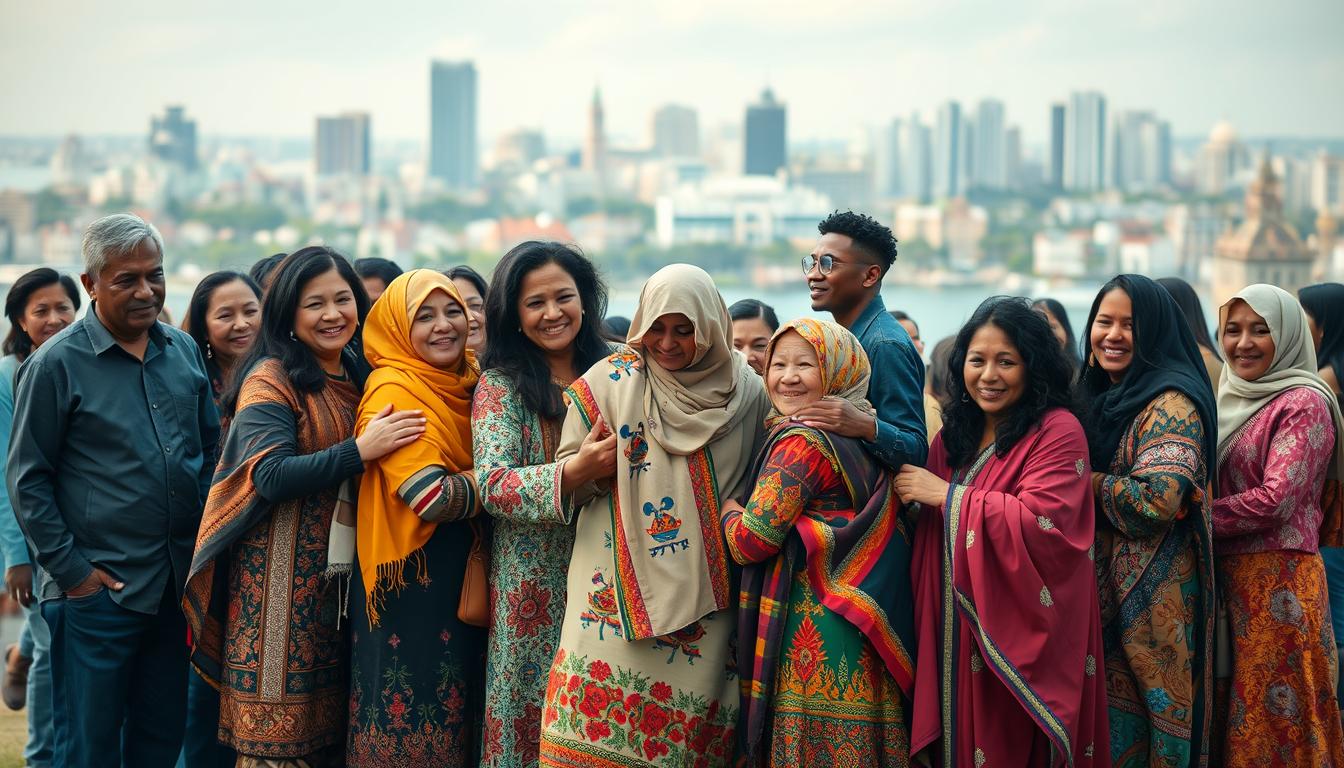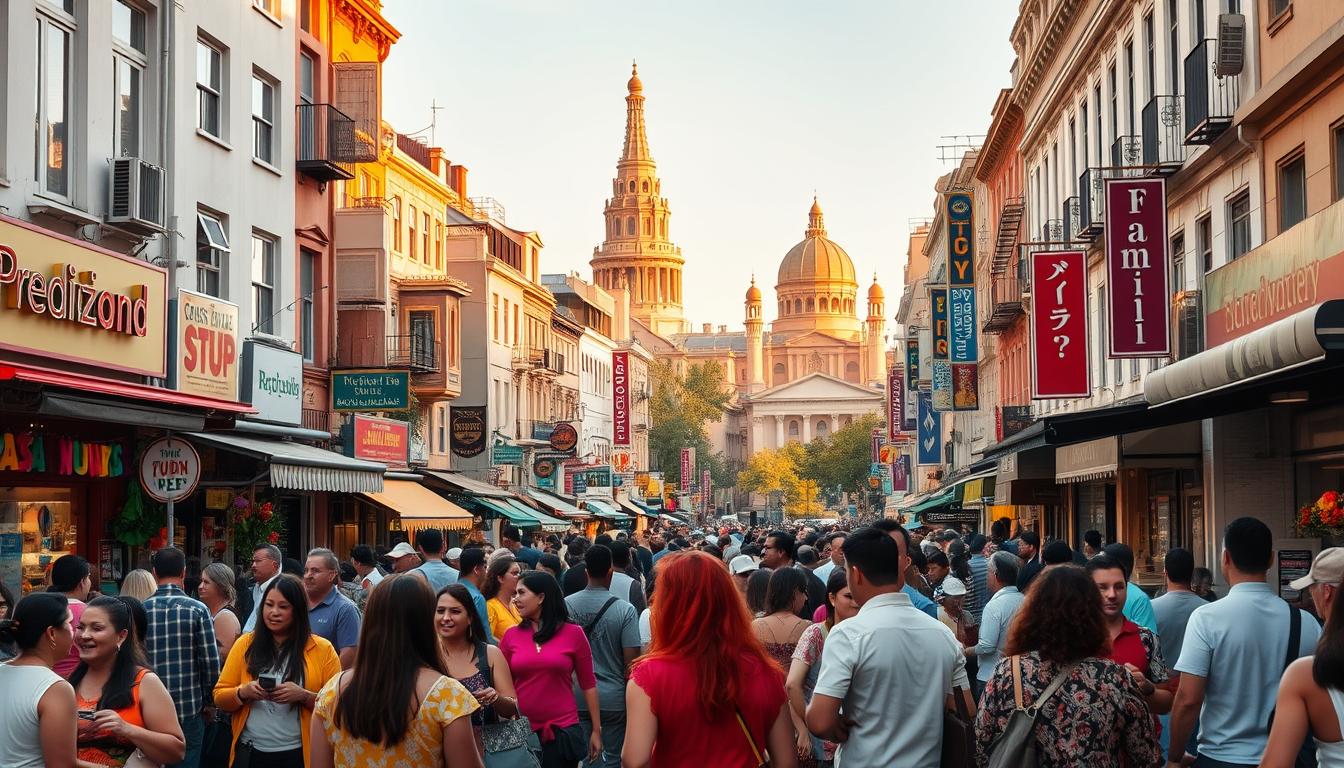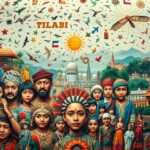Discovering and embracing your unique heritage is a journey of self-discovery and cultural appreciation. Your cultural background is a rich tapestry woven from the traditions, values, and experiences of your community.
Understanding your heritage is crucial in forming your identity. It influences your perspectives, shapes your values, and connects you to your community. Embracing this heritage allows you to appreciate the diversity that surrounds you and fosters a deeper understanding of yourself and your place in the world.
Key Takeaways
- Embracing your heritage is essential for self-discovery.
- Cultural background significantly influences personal identity.
- Understanding your heritage fosters appreciation for diversity.
- Heritage plays a crucial role in shaping individual perspectives.
- Appreciating your cultural identity enhances community connections.
What Defines Cultural Identity?
The question of what defines our cultural identity is both profound and personal. Cultural identity is not just about where we come from, but also about who we are and how we perceive ourselves within the context of our culture.
The Building Blocks of Who We Are
Cultural identity is formed through various elements, including cultural roots, family traditions, language, and geographical location. These components intertwine to shape our identity formation process.
The Intersection of Personal and Collective Identity
Our personal identity intersects with our collective cultural identity in complex ways. While personal experiences shape our individual perspectives, our collective cultural identity influences our values and beliefs.
How Geography Shapes Cultural Identity
Geography plays a significant role in shaping our cultural identity. The environment and region we grow up in influence our cultural practices, dietary habits, and even our language.
For instance, communities near coastal areas may develop cultural practices centered around fishing and seafood, whereas mountainous regions might have traditions related to agriculture and pastoralism.
The Role of Historical Context
Historical context is another crucial factor in defining cultural identity. Historical events, migrations, and cultural exchanges have shaped the cultural narratives of communities worldwide.
“Culture is the way we do things around here,” as the saying goes, reflecting how deeply ingrained cultural practices are in our daily lives.
Understanding the historical context of our cultural heritage helps us appreciate the complexities of our identity and the factors that have influenced it over time.
The Components of Cultural Identity
Cultural identity is multifaceted, encompassing language, customs, and belief systems that influence our daily lives. It is the culmination of various elements that together shape how individuals perceive themselves and their place within their community.
Language and Communication Styles
Language plays a pivotal role in cultural identity, serving not only as a means of communication but also as a carrier of cultural heritage. The nuances of language, including dialects and idioms, contribute to the richness of cultural expression. Effective communication within a culture involves not just the words used, but also non-verbal cues and context.
Traditions, Customs, and Rituals
Traditions and customs are vital components of cultural identity, providing a sense of continuity and connection to the past. They are often manifested in rituals and ceremonies that mark important life events or seasonal changes. These practices help to reinforce cultural values and strengthen community bonds.
Values and Belief Systems
The values and beliefs held by a culture significantly influence its identity. These can include moral principles, religious beliefs, and social norms. Religious influences often play a crucial role in shaping cultural identity.
Religious Influences on Cultural Identity
Religion can profoundly impact cultural practices, ethics, and worldview. It often informs rituals, dietary habits, and social behaviors, contributing to the distinctiveness of a culture.
Family Structures and Dynamics
Family structures and dynamics are another critical aspect of cultural identity. The way families are organized, the roles within the family, and the values transmitted through family ties all contribute to the cultural fabric. Family dynamics can vary significantly across cultures, influencing individual behaviors and expectations.
| Component | Description | Impact on Cultural Identity |
|---|---|---|
| Language | Means of communication and carrier of cultural heritage | Shapes cultural expression and community interaction |
| Traditions and Customs | Provide continuity and connection to the past | Reinforces cultural values and community bonds |
| Values and Belief Systems | Influence moral principles and social norms | Shapes cultural identity and informs behaviors |
Understanding Your Cultural Roots
Understanding your cultural roots is essential to embracing your identity. It’s a journey that involves tracing your family history, understanding the stories that have been passed down through generations, and connecting with your ancestral homelands.
Tracing Your Family History
Tracing your family history is a crucial step in understanding your cultural roots. It involves researching your ancestors, their lives, and the historical context in which they lived. This can be done through various means, including genealogy research and DNA testing.
Genealogy Resources for Americans
For Americans, genealogy research can be a fascinating way to uncover your cultural heritage. Resources such as the National Archives, genealogy websites like Ancestry.com, and local historical societies can provide valuable information about your ancestors.
DNA Testing and Heritage Discovery
DNA testing has become a popular tool for discovering one’s heritage. Services like 23andMe and AncestryDNA can provide insights into your ancestral origins and connect you with distant relatives who share your DNA.
The Stories That Shape Us
The stories that are passed down through generations play a significant role in shaping our understanding of ourselves and our cultural identity. These stories can include family legends, historical events, and cultural traditions.
Connecting With Ancestral Homelands
Connecting with your ancestral homelands can be a powerful way to deepen your understanding of your cultural roots. This can involve traveling to the countries or regions from which your ancestors originated, participating in cultural events, or simply learning more about the history and customs of those places.
| Resource | Description | Benefit |
|---|---|---|
| National Archives | Official records and documents | Detailed historical information |
| Ancestry.com | Genealogy database | Access to extensive family history records |
| 23andMe | DNA testing service | Insights into ancestral origins and genetic health |
By tracing your family history, understanding the stories that shape you, and connecting with your ancestral homelands, you can gain a deeper appreciation for your cultural roots and a stronger sense of identity.
Navigating Multiple Cultural Identities
The experience of being bicultural or multicultural is more common than ever, bringing both challenges and opportunities for personal growth. As individuals navigate multiple cultural identities, they encounter a unique set of circumstances that can enrich their lives.
Bicultural and Multicultural Experiences
Being bicultural or multicultural means embracing more than one cultural identity. This can be due to various factors such as having parents from different cultural backgrounds, living in a foreign country, or being part of a multicultural community. Bicultural individuals often report feeling a deeper understanding of different cultures and being more adaptable.

Code-Switching and Cultural Adaptation
One of the key aspects of navigating multiple cultural identities is the phenomenon of code-switching. This refers to the practice of switching between different languages, dialects, or cultural behaviors depending on the context. Code-switching can be a powerful tool for connecting with different communities, but it can also be challenging, as it requires a high degree of cultural awareness and adaptability.
Finding Balance Between Different Cultural Influences
Finding a balance between different cultural influences is crucial for individuals with multiple cultural identities. This involves embracing the positive aspects of each culture while navigating potential conflicts or differences. A balanced approach allows individuals to maintain their cultural heritage while adapting to new cultural contexts.
The Immigrant Experience in America
For many immigrants, navigating multiple cultural identities is a daily reality. The immigrant experience in America is characterized by the challenge of maintaining one’s cultural heritage while integrating into American society. This balancing act can be both enriching and challenging, as individuals strive to preserve their cultural roots while embracing new cultural influences.
Third Culture Kids and Cultural Hybridity
Third Culture Kids (TCKs) are individuals who have spent their formative years in multiple cultures, often due to their parents’ international work or other circumstances. TCKs experience a unique form of cultural hybridity, blending elements from different cultures to form their identity. This experience can foster a global perspective and cultural adaptability, valuable assets in today’s interconnected world.
| Aspect | Bicultural Experience | Multicultural Experience |
|---|---|---|
| Cultural Identity | Identifying with two cultures | Identifying with multiple cultures |
| Code-Switching | Switching between two languages or cultural behaviors | Switching between multiple languages or cultural behaviors |
| Cultural Adaptation | Adapting to two different cultural contexts | Adapting to multiple cultural contexts |
Challenges in Preserving Cultural Identity
One of the most significant challenges individuals face is preserving their cultural identity amidst societal expectations. In a diverse society like the United States, maintaining cultural heritage can be particularly daunting.
Assimilation Pressures in American Society
The pressure to assimilate into the dominant culture can be overwhelming, often leading to a dilution of cultural identity. Many individuals struggle to balance their cultural heritage with the need to fit into mainstream society.
Generational Gaps in Cultural Understanding
Generational gaps can also pose a significant challenge. As younger generations become more integrated into American culture, they may lose touch with their ancestral traditions, causing a rift between them and their elders.
Dealing With Cultural Stereotypes and Discrimination
Cultural stereotypes and discrimination can further complicate the preservation of cultural identity. Individuals may face prejudice or marginalization, making it difficult to maintain their cultural practices openly.
Reclaiming Lost Cultural Practices
Reclaiming lost cultural practices is a crucial step in preserving cultural identity. This can involve relearning traditional practices, reconnecting with cultural roots, and passing on cultural knowledge to younger generations.
Healing from Cultural Trauma
For many communities, cultural trauma has been a significant barrier to preserving cultural identity. Healing from this trauma requires acknowledging the past, seeking support from community members, and finding ways to restore cultural practices that were lost due to historical injustices.
The Power of Cultural Identity in Personal Development
Our cultural identity is a rich tapestry that influences our self-concept, values, and overall well-being. It is the foundation upon which we build our understanding of ourselves and our place in the world.
How Cultural Identity Shapes Self-Concept
Cultural identity significantly influences how we perceive ourselves. It shapes our values, beliefs, and practices, which in turn affect our self-concept. By understanding and embracing our cultural heritage, we can develop a stronger, more positive self-image.
Cultural practices and traditions play a crucial role in this process. For instance, participating in cultural festivals and rituals can enhance our sense of belonging and identity.
Cultural Values as a Moral Compass
Cultural values serve as a moral compass, guiding our decisions and actions. These values are often passed down through generations and provide a sense of continuity and direction.
- Respect for elders
- Community solidarity
- Resilience in the face of adversity
By adhering to these values, individuals can navigate life’s challenges with a clearer sense of purpose and integrity.
Finding Strength in Cultural Heritage During Difficult Times
Cultural heritage can be a source of strength during difficult times. The stories, traditions, and practices that make up our cultural identity can provide comfort, resilience, and hope.
Cultural Identity and Mental Health
A strong cultural identity can positively impact mental health by providing a sense of belonging and support. It can also offer coping mechanisms and strategies for dealing with stress and adversity.
Connecting with one’s cultural heritage can build confidence by fostering a sense of pride and self-worth. It encourages individuals to embrace their unique identity and celebrate their cultural background.
By embracing our cultural identity, we can lead more authentic, confident lives, better equipped to navigate the complexities of the modern world.
Embracing Your Cultural Identity in Daily Life
Your cultural identity is a vibrant tapestry that can add depth and meaning to your daily experiences. As you navigate the complexities of modern life, incorporating your cultural heritage can provide a sense of grounding and connection to your roots.
Incorporating Cultural Practices Into Modern Routines
One of the most effective ways to embrace your cultural identity is by integrating traditional practices into your daily routines. This could involve starting your day with a meditation practice inspired by your cultural heritage or incorporating traditional recipes into your meal planning. By doing so, you create a seamless blend of old and new, honoring your roots while embracing the present.
For example, you might begin your morning with a traditional tea ceremony, a practice that not only connects you with your cultural heritage but also sets a mindful tone for the day. Similarly, cooking a traditional meal can be a powerful way to connect with your family’s history and cultural traditions.
Celebrating Cultural Holidays and Festivals
Celebrating cultural holidays and festivals is another meaningful way to embrace your cultural identity. These events are often rich in tradition and provide an opportunity to connect with your community and heritage. Whether it’s participating in a cultural parade, preparing traditional foods for a holiday, or engaging in the rituals associated with a particular festival, these activities can deepen your connection to your cultural roots.
“Festivals and holidays are a time for celebration, reflection, and connection with our heritage. They offer a chance to step away from the daily routine and immerse ourselves in the traditions and stories that define us.”
Expressing Cultural Identity Through Food, Art, and Music
Food, art, and music are powerful mediums through which you can express your cultural identity. Cooking traditional dishes or learning a traditional art form can be a fulfilling way to connect with your heritage. Similarly, engaging with the music of your culture, whether through listening, dancing, or playing an instrument, can be a joyful expression of your identity.
Creating Cultural Rituals for Modern Life
Incorporating cultural rituals into your modern life can provide a sense of continuity and connection to your heritage. This might involve creating new rituals that blend traditional practices with contemporary needs. For instance, you might develop a weekly or monthly ritual that honors your cultural heritage, such as a family dinner night with traditional foods or a regular cultural practice session.
Cultural Fashion and Personal Style
Your cultural identity can also be expressed through your personal style and fashion choices. Incorporating traditional clothing or accessories into your wardrobe can be a beautiful way to honor your heritage. Moreover, understanding the cultural significance behind certain garments or adornments can add depth to your personal style, making it not just a form of self-expression but also a connection to your cultural roots.
By embracing your cultural identity in these various ways, you can enrich your daily life with the depth and richness of your heritage, creating a more authentic and fulfilling experience.
Sharing Your Heritage With Others
Sharing our cultural identity with others fosters understanding, respect, and a sense of community. It’s through sharing that we truly appreciate the richness of our heritage.
Teaching Cultural Traditions to the Next Generation
One of the most significant ways to share our cultural heritage is by teaching our traditions to the younger generation. This can be done through formal education, family gatherings, or daily practices. By passing down our stories, customs, and values, we ensure the continuation of our cultural identity.
Cultural Exchange in Diverse Communities
Cultural exchange programs offer a unique opportunity for people from different backgrounds to learn from each other. These exchanges can happen in schools, workplaces, or community centers, promoting mutual respect and understanding.
Being an Ambassador of Your Culture
Being a cultural ambassador involves representing your culture in a positive and respectful manner. This can be achieved through various means, such as:
- Participating in cultural festivals and events
- Sharing traditional cuisine
- Teaching cultural practices to others
- Engaging in cultural discussions and exchanges
Hosting Cultural Events and Gatherings
Hosting cultural events is an excellent way to share our heritage. These events can range from traditional holiday celebrations to cultural workshops. They provide a platform for people to come together and experience different cultures firsthand.
Storytelling as Cultural Preservation
Storytelling is a powerful tool for preserving cultural heritage. Through stories, we can pass down historical events, myths, and cultural values. It’s a way to keep our heritage alive and vibrant.
| Cultural Practice | Method of Sharing | Benefit |
|---|---|---|
| Traditional Cooking | Cooking Classes | Preserves culinary heritage |
| Storytelling | Oral Traditions | Passes down cultural values and history |
| Cultural Festivals | Community Events | Fosters community and cultural understanding |

Cultural Identity in the Digital Age
The digital age has transformed how we express and preserve our cultural identities. With the rise of social media and virtual communities, people can now connect with others who share similar cultural backgrounds and interests.
Social Media as a Tool for Cultural Expression
Social media platforms have become essential tools for cultural expression. They allow individuals to share their cultural practices, traditions, and values with a global audience. For instance, platforms like Instagram and YouTube are filled with content showcasing cultural festivals, traditional cooking, and folk music.
Virtual Communities and Cultural Preservation
Virtual communities play a crucial role in preserving cultural heritage. Online forums and social media groups dedicated to specific cultural practices help keep traditions alive. These communities provide a space for people to share their experiences, ask questions, and learn from one another.
Balancing Global Citizenship and Cultural Roots
In the digital age, individuals can be part of a global community while maintaining their cultural roots. This balance is achieved through the selective adoption of global trends and the preservation of traditional practices. For example, someone might celebrate global cultural festivals while also observing their own cultural traditions.
Digital Archives and Cultural Memory
Digital archives are vital for preserving cultural memory. They store historical documents, cultural artifacts, and personal stories, making them accessible to future generations. Institutions and communities are creating digital archives to safeguard their cultural heritage.
Online Resources for Cultural Education
Online resources are revolutionizing cultural education. Websites, online courses, and educational platforms provide opportunities for people to learn about different cultures. This not only promotes cultural understanding but also helps in preserving cultural heritage.
| Cultural Aspect | Traditional Method | Digital Method |
|---|---|---|
| Cultural Expression | Festivals and Events | Social Media Campaigns |
| Cultural Preservation | Physical Archives | Digital Archives |
| Cultural Education | Classroom Learning | Online Courses |
Conclusion: The Ongoing Journey of Cultural Identity
Embracing your cultural identity is a lifelong journey that enriches your life with every step. As you’ve explored throughout this article, understanding and celebrating your cultural heritage is crucial to personal growth and self-awareness.
By tracing your family history, embracing cultural traditions, and navigating the complexities of multiple identities, you can deepen your connection to your roots. This journey not only shapes your self-concept but also provides a moral compass that guides you through life’s challenges.
As you continue on your cultural identity journey, remember that it’s okay to evolve and adapt. Your cultural heritage is a dynamic part of who you are, influencing your values, practices, and relationships. By embracing this journey, you can foster a stronger sense of self and contribute to a more diverse and inclusive community.
Ultimately, the path to embracing your cultural identity is unique to you. By staying true to your heritage and open to growth, you can cultivate a richer understanding of yourself and your place in the world.
FAQ
What is cultural identity, and why is it important?
Cultural identity refers to the aspects that define an individual’s or group’s heritage, including traditions, values, and customs. It’s essential because it influences self-concept, provides a sense of belonging, and shapes our understanding of the world.
How do I discover my cultural identity?
Discovering your cultural identity involves tracing your family history, learning about your ancestral homelands, and exploring the stories and traditions passed down through generations. You can also use genealogy resources and DNA testing to uncover more about your heritage.
What are the challenges of navigating multiple cultural identities?
Navigating multiple cultural identities can be complex, involving code-switching, cultural adaptation, and balancing different cultural influences. It requires understanding and embracing the various aspects of your identities to find a sense of unity and self.
How can I preserve my cultural identity in a diverse society?
Preserving cultural identity involves practicing and passing on cultural traditions, celebrating cultural holidays, and expressing cultural identity through food, art, and music. It also requires resilience against assimilation pressures and stereotypes.
How does cultural identity impact personal development?
Cultural identity significantly influences personal development by shaping self-concept, serving as a moral compass, and providing strength during difficult times. It can also impact mental health and confidence by connecting individuals with their heritage.
Can I incorporate my cultural practices into modern life?
Yes, incorporating cultural practices into modern routines can be a meaningful way to honor your heritage. This can include celebrating cultural holidays, cooking traditional meals, and creating cultural rituals for modern life.
How can I share my cultural heritage with others?
Sharing your cultural heritage can be achieved by teaching cultural traditions to the next generation, participating in cultural exchange, and being an ambassador of your culture. Hosting cultural events and storytelling are also effective ways to preserve and share your heritage.
What role does social media play in cultural identity?
Social media serves as a tool for cultural expression, allowing individuals to share their cultural practices, traditions, and stories with a broader audience. It also facilitates the formation of virtual communities centered around shared cultural identities.
How can I balance global citizenship with maintaining my cultural roots?
Balancing global citizenship with cultural roots involves embracing the global community while staying connected to your cultural heritage. This can be achieved by engaging with diverse cultures, using digital resources for cultural education, and preserving cultural traditions.



